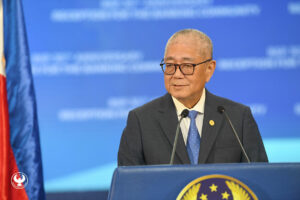By Keisha B. Ta-asan, Reporter
THE BANGKO SENTRAL ng Pilipinas (BSP) is unlikely to cut borrowing costs at its meeting next month, as rates need to be sufficiently tight amid evolving risks to inflation, its governor said late Monday.
In a gathering with newspaper editors, BSP Governor Eli M. Remolona, Jr. said a rate cut is unlikely on Feb. 15, the Monetary Board’s first policy review this year, noting the risk-adjusted inflation forecast in 2024 is still above the 2-4% target.
“At this point, a rate cut is not likely (on) Feb. 15,” Mr. Remolona said in mixed English and Filipino, adding that the “numbers we are seeing” show the need to keep policy settings sufficiently tight for some time.
The Monetary Board hiked borrowing costs by 450 basis points (bps) from May 2022 to October 2023, bringing the key interest rate to a 16-year high of 6.5% to tame inflation.
At the December meeting, the BSP’s risk-adjusted inflation forecast stood at 4.2% this year and 3.4% for 2025.
Meanwhile, the BSP’s average inflation baseline forecast is 3.7% for 2024 and 3.2% for next year.
Rising tensions in the Red Sea and a prolonged El Niño weather episode are upside risks that are included in the risk-adjusted forecast, BSP Deputy Governor Francisco G. Dakila, Jr. said.
Houthi militants have continued to attack commercial shipping vessels traveling through the lower Red Sea since November last year.
Mr. Dakila noted El Niño is now expected to continue through the second quarter, instead of the first quarter as expected.
The state weather agency expects El Niño to persist until May this year. Earlier estimates by the BSP also showed that the dry weather event could raise inflation by 0.02 percentage point.
Mr. Remolona said inflation is projected to slow in January from 3.9% in December due to base effects, which could also drive inflation down in February or March.
Inflation peaked at 8.7% in January last year as food prices soared. It has since come down to a 22-month low in December.
For 2023, inflation averaged 6%, slightly higher than 5.8% in 2022. This marked the second straight year that inflation breached the BSP’s 2-4% target.
Security Bank Corp. Chief Economist Robert Dan J. Roces said that despite base effects, inflation might remain elevated in the coming months due to external risks.
“The BSP will (and should) maintain a tight monetary policy stance in the medium term to stabilize prices,” he said.
He added that El Niño could lead to droughts and agricultural price hikes, which could push up inflation. Disruptions in the Red Sea may also increase import costs.
However, a weaker global demand could lead to lower commodity prices and dampen domestic demand. An improvement in the supply chain might also drive input costs lower, which could put a downward pressure on inflation, Mr. Roces added.
CHINA SLOWDOWNThe projected economic slowdown in China could dampen the Philippines’ growth outlook this year, according to Mr. Remolona.
“I’m more optimistic about the Philippine economy, but less about the global (economy),” he said.
“China is a concern… It looks like a long slowdown, not a temporary slowdown,” he said, adding that market players now see the Chinese economy expanding by about 5% in 2023 from earlier projections of 10%.
Mr. Remolona noted that China is one of the Philippines’ major trading partners and a good source of investments.
The Philippines should diversify its trade and investment partners, he added.
Mr. Roces said a slowing Chinese economy could impact the economy via trade, investments and tourism. The Philippines needs diversification strategies to mitigate its impact.
“Reduced demand for Philippine exports, especially electronics, garments and agricultural products would shrink the country’s economic pie. This slowdown could also disrupt supply chains, causing production bottlenecks and price hikes across various industries,” he said.
Based on data from the local statistics agency, the United States was the top destination of locally made products in November with a 16% share worth $1.14 billion. It was followed by Japan (13.2% share worth $938.3 million) and China (12.3% share valued at $876.27 million).
Meanwhile, China remained the Philippines’ main source of imported goods with a value of $2.6 billion, accounting for 24% of the total.
“A potential decrease in Chinese foreign direct investment (FDI), which is crucial for infrastructure and tourism, could hamper economic growth and job creation. Capital flight from the region due to the slowdown might weaken the peso, further boosting import costs and fueling inflation,” Mr. Roces said.
Central bank data showed FDI inflows from China fell by 19.1% to $12.53 million as of October 2023 from $15.49 million a year ago.
Meanwhile, fewer Chinese tourists visiting the Philippines would affect local businesses and the hospitality industry, Mr. Roces said.
“I agree with BSP Governor Remolona’s assessment that the Philippines should diversify its trade and investment partners to mitigate the risks associated with a slowdown in China,” he said.
“Diversification could involve focusing on other regional markets like Southeast Asia or the United States, developing domestic industries and attracting investments from diverse sources,” he added.
